Query an Array of Embedded Documents
On this page
➤ Use the Select your language drop-down menu in the upper-right to set the language of the following examples.
This page provides examples of query operations on an array of nested documents using the
db.collection.find() method in mongosh.
The examples on this page use the inventory collection. Connect to a
test database in your MongoDB instance then create the inventory
collection:
This page provides examples of query operations on an array of nested documents using MongoDB Compass.
The examples on this page use the inventory collection. Connect to a
test database in your MongoDB instance then create the inventory
collection:
This page provides examples of query operations on an array of nested documents using the MongoCollection.Find() method in the MongoDB C# Driver.
The examples on this page use the inventory collection. Connect to a
test database in your MongoDB instance then create the inventory
collection:
This page provides examples of query operations on an array of nested documents using the Collection.Find function in the MongoDB Go Driver.
The examples on this page use the inventory collection. Connect to a
test database in your MongoDB instance then create the inventory
collection:
This page provides examples of query operations on an array of nested documents using the com.mongodb.reactivestreams.client.MongoCollection.find method in the MongoDB Java Reactive Streams Driver.
The examples on this page use the inventory collection. Connect to a
test database in your MongoDB instance then create the inventory
collection:
This page provides examples of query operations on an array of nested documents using the com.mongodb.client.MongoCollection.find method in the MongoDB Java Synchronous Driver.
Tip
The driver provides com.mongodb.client.model.Filters helper methods to facilitate the creation of filter documents. The examples on this page use these methods to create the filter documents.
The examples on this page use the inventory collection. Connect to a
test database in your MongoDB instance then create the inventory
collection:
This page provides examples of query operations on an array of nested documents using the
motor.motor_asyncio.AsyncIOMotorCollection.find
method in the Motor
driver.
The examples on this page use the inventory collection. Connect to a
test database in your MongoDB instance then create the inventory
collection:
This page provides examples of query operations on an array of nested documents using the Collection.find() method in the MongoDB Node.js Driver.
The examples on this page use the inventory collection. Connect to a
test database in your MongoDB instance then create the inventory
collection:
This page provides examples of query operations on an array of nested documents using the MongoDB::Collection::find() method in the MongoDB Perl Driver.
The examples on this page use the inventory collection. Connect to a
test database in your MongoDB instance then create the inventory
collection:
This page provides examples of query operations on an array of nested documents using the
MongoDB\\Collection::find()
method in the
MongoDB PHP Library.
The examples on this page use the inventory collection. Connect to a
test database in your MongoDB instance then create the inventory
collection:
This page provides examples of query operations on an array of nested documents using the
pymongo.collection.Collection.find method in the
PyMongo
Python driver.
The examples on this page use the inventory collection. Connect to a
test database in your MongoDB instance then create the inventory
collection:
This page provides examples of query operations on an array of nested documents using the Mongo::Collection#find() method in the MongoDB Ruby Driver.
The examples on this page use the inventory collection. Connect to a
test database in your MongoDB instance then create the inventory
collection:
This page provides examples of query operations on an array of nested documents using the collection.find() method in the MongoDB Scala Driver.
The examples on this page use the inventory collection. Connect to a
test database in your MongoDB instance then create the inventory
collection:
db.inventory.insertMany( [ { item: "journal", instock: [ { warehouse: "A", qty: 5 }, { warehouse: "C", qty: 15 } ] }, { item: "notebook", instock: [ { warehouse: "C", qty: 5 } ] }, { item: "paper", instock: [ { warehouse: "A", qty: 60 }, { warehouse: "B", qty: 15 } ] }, { item: "planner", instock: [ { warehouse: "A", qty: 40 }, { warehouse: "B", qty: 5 } ] }, { item: "postcard", instock: [ { warehouse: "B", qty: 15 }, { warehouse: "C", qty: 35 } ] } ]);
[ { "item": "journal", "instock": [ { "warehouse": "A", "qty": 5 }, { "warehouse": "C", "qty": 15 } ] }, { "item": "notebook", "instock": [ { "warehouse": "C", "qty": 5 } ] }, { "item": "paper", "instock": [ { "warehouse": "A", "qty": 60 }, { "warehouse": "B", "qty": 15 } ] }, { "item": "planner", "instock": [ { "warehouse": "A", "qty": 40 }, { "warehouse": "B", "qty": 5 } ] }, { "item": "postcard", "instock": [ { "warehouse": "B","qty": 15 }, { "warehouse": "C", "qty": 35 } ] } ]
For instructions on inserting documents in MongoDB Compass, see Insert Documents.
var documents = new[] { new BsonDocument { { "item", "journal" }, { "instock", new BsonArray { new BsonDocument { { "warehouse", "A" }, { "qty", 5 } }, new BsonDocument { { "warehouse", "C" }, { "qty", 15 } } } } }, new BsonDocument { { "item", "notebook" }, { "instock", new BsonArray { new BsonDocument { { "warehouse", "C" }, { "qty", 5 } } } } }, new BsonDocument { { "item", "paper" }, { "instock", new BsonArray { new BsonDocument { { "warehouse", "A" }, { "qty", 60 } }, new BsonDocument { { "warehouse", "B" }, { "qty", 15 } } } } }, new BsonDocument { { "item", "planner" }, { "instock", new BsonArray { new BsonDocument { { "warehouse", "A" }, { "qty", 40 } }, new BsonDocument { { "warehouse", "B" }, { "qty", 5 } } } } }, new BsonDocument { { "item", "postcard" }, { "instock", new BsonArray { new BsonDocument { { "warehouse", "B" }, { "qty", 15 } }, new BsonDocument { { "warehouse", "C" }, { "qty", 35 } } } } } }; collection.InsertMany(documents);
docs := []interface{}{ bson.D{ {"item", "journal"}, {"instock", bson.A{ bson.D{ {"warehouse", "A"}, {"qty", 5}, }, bson.D{ {"warehouse", "C"}, {"qty", 15}, }, }}, }, bson.D{ {"item", "notebook"}, {"instock", bson.A{ bson.D{ {"warehouse", "C"}, {"qty", 5}, }, }}, }, bson.D{ {"item", "paper"}, {"instock", bson.A{ bson.D{ {"warehouse", "A"}, {"qty", 60}, }, bson.D{ {"warehouse", "B"}, {"qty", 15}, }, }}, }, bson.D{ {"item", "planner"}, {"instock", bson.A{ bson.D{ {"warehouse", "A"}, {"qty", 40}, }, bson.D{ {"warehouse", "B"}, {"qty", 5}, }, }}, }, bson.D{ {"item", "postcard"}, {"instock", bson.A{ bson.D{ {"warehouse", "B"}, {"qty", 15}, }, bson.D{ {"warehouse", "C"}, {"qty", 35}, }, }}, }, } result, err := coll.InsertMany(context.TODO(), docs)
Publisher<Success> insertManyPublisher = collection.insertMany(asList( Document.parse("{ item: 'journal', instock: [ { warehouse: 'A', qty: 5 }, { warehouse: 'C', qty: 15 } ] }"), Document.parse("{ item: 'notebook', instock: [ { warehouse: 'C', qty: 5 } ] }"), Document.parse("{ item: 'paper', instock: [ { warehouse: 'A', qty: 60 }, { warehouse: 'B', qty: 15 } ] }"), Document.parse("{ item: 'planner', instock: [ { warehouse: 'A', qty: 40 }, { warehouse: 'B', qty: 5 } ] }"), Document.parse("{ item: 'postcard', instock: [ { warehouse: 'B', qty: 15 }, { warehouse: 'C', qty: 35 } ] }") ));
collection.insertMany(asList( Document.parse("{ item: 'journal', instock: [ { warehouse: 'A', qty: 5 }, { warehouse: 'C', qty: 15 } ] }"), Document.parse("{ item: 'notebook', instock: [ { warehouse: 'C', qty: 5 } ] }"), Document.parse("{ item: 'paper', instock: [ { warehouse: 'A', qty: 60 }, { warehouse: 'B', qty: 15 } ] }"), Document.parse("{ item: 'planner', instock: [ { warehouse: 'A', qty: 40 }, { warehouse: 'B', qty: 5 } ] }"), Document.parse("{ item: 'postcard', instock: [ { warehouse: 'B', qty: 15 }, { warehouse: 'C', qty: 35 } ] }") ));
# Subdocument key order matters in a few of these examples so we have # to use bson.son.SON instead of a Python dict. from bson.son import SON await db.inventory.insert_many( [ { "item": "journal", "instock": [ SON([("warehouse", "A"), ("qty", 5)]), SON([("warehouse", "C"), ("qty", 15)]), ], }, {"item": "notebook", "instock": [SON([("warehouse", "C"), ("qty", 5)])]}, { "item": "paper", "instock": [ SON([("warehouse", "A"), ("qty", 60)]), SON([("warehouse", "B"), ("qty", 15)]), ], }, { "item": "planner", "instock": [ SON([("warehouse", "A"), ("qty", 40)]), SON([("warehouse", "B"), ("qty", 5)]), ], }, { "item": "postcard", "instock": [ SON([("warehouse", "B"), ("qty", 15)]), SON([("warehouse", "C"), ("qty", 35)]), ], }, ] )
await db.collection('inventory').insertMany([ { item: 'journal', instock: [ { warehouse: 'A', qty: 5 }, { warehouse: 'C', qty: 15 } ] }, { item: 'notebook', instock: [{ warehouse: 'C', qty: 5 }] }, { item: 'paper', instock: [ { warehouse: 'A', qty: 60 }, { warehouse: 'B', qty: 15 } ] }, { item: 'planner', instock: [ { warehouse: 'A', qty: 40 }, { warehouse: 'B', qty: 5 } ] }, { item: 'postcard', instock: [ { warehouse: 'B', qty: 15 }, { warehouse: 'C', qty: 35 } ] } ]);
# Subdocument key order matters in this example so we have # to use Tie::IxHash instead of a regular, unordered Perl hash. $db->coll("inventory")->insert_many( [ { item => "journal", instock => [ Tie::IxHash->new( warehouse => "A", qty => 5 ), Tie::IxHash->new( warehouse => "C", qty => 15 ) ] }, { item => "notebook", instock => [ Tie::IxHash->new( warehouse => "C", qty => 5 ) ] }, { item => "paper", instock => [ Tie::IxHash->new( warehouse => "A", qty => 60 ), Tie::IxHash->new( warehouse => "B", qty => 15 ) ] }, { item => "planner", instock => [ Tie::IxHash->new( warehouse => "A", qty => 40 ), Tie::IxHash->new( warehouse => "B", qty => 5 ) ] }, { item => "postcard", instock => [ Tie::IxHash->new( warehouse => "B", qty => 15 ), Tie::IxHash->new( warehouse => "C", qty => 35 ) ] } ] );
$insertManyResult = $db->inventory->insertMany([ [ 'item' => 'journal', 'instock' => [ ['warehouse' => 'A', 'qty' => 5], ['warehouse' => 'C', 'qty' => 15], ], ], [ 'item' => 'notebook', 'instock' => [ ['warehouse' => 'C', 'qty' => 5], ], ], [ 'item' => 'paper', 'instock' => [ ['warehouse' => 'A', 'qty' => 60], ['warehouse' => 'B', 'qty' => 15], ], ], [ 'item' => 'planner', 'instock' => [ ['warehouse' => 'A', 'qty' => 40], ['warehouse' => 'B', 'qty' => 5], ], ], [ 'item' => 'postcard', 'instock' => [ ['warehouse' => 'B', 'qty' => 15], ['warehouse' => 'C', 'qty' => 35], ], ], ]);
# Subdocument key order matters in a few of these examples so we have # to use bson.son.SON instead of a Python dict. from bson.son import SON db.inventory.insert_many( [ { "item": "journal", "instock": [ SON([("warehouse", "A"), ("qty", 5)]), SON([("warehouse", "C"), ("qty", 15)]), ], }, {"item": "notebook", "instock": [SON([("warehouse", "C"), ("qty", 5)])]}, { "item": "paper", "instock": [ SON([("warehouse", "A"), ("qty", 60)]), SON([("warehouse", "B"), ("qty", 15)]), ], }, { "item": "planner", "instock": [ SON([("warehouse", "A"), ("qty", 40)]), SON([("warehouse", "B"), ("qty", 5)]), ], }, { "item": "postcard", "instock": [ SON([("warehouse", "B"), ("qty", 15)]), SON([("warehouse", "C"), ("qty", 35)]), ], }, ] )
client[:inventory].insert_many([{ item: 'journal', instock: [ { warehouse: 'A', qty: 5 }, { warehouse: 'C', qty: 15 }] }, { item: 'notebook', instock: [ { warehouse: 'C', qty: 5 }] }, { item: 'paper', instock: [ { warehouse: 'A', qty: 60 }, { warehouse: 'B', qty: 15 }] }, { item: 'planner', instock: [ { warehouse: 'A', qty: 40 }, { warehouse: 'B', qty: 5 }] }, { item: 'postcard', instock: [ { warehouse: 'B', qty: 15 }, { warehouse: 'C', qty: 35 }] } ])
collection.insertMany(Seq( Document("""{ item: "journal", instock: [ { warehouse: "A", qty: 5 }, { warehouse: "C", qty: 15 } ] }"""), Document("""{ item: "notebook", instock: [ { warehouse: "C", qty: 5 } ] }"""), Document("""{ item: "paper", instock: [ { warehouse: "A", qty: 60 }, { warehouse: "B", qty: 15 } ] }"""), Document("""{ item: "planner", instock: [ { warehouse: "A", qty: 40 }, { warehouse: "B", qty: 5 } ] }"""), Document("""{ item: "postcard", instock: [ { warehouse: "B", qty: 15 }, { warehouse: "C", qty: 35 } ] }""") )).execute()
Query for a Document Nested in an Array
The following example selects all documents where an element in the
instock array matches the specified document:
db.inventory.find( { "instock": { warehouse: "A", qty: 5 } } )
Copy the following filter into the Compass query bar and click Find:
{ "instock": { warehouse: "A", qty: 5 } }
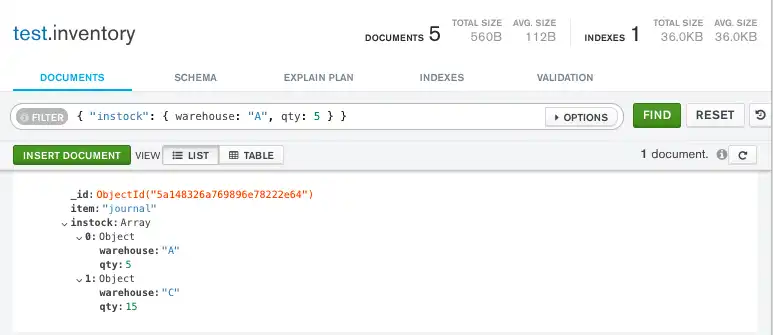
var filter = Builders<BsonDocument>.Filter.AnyEq("instock", new BsonDocument { { "warehouse", "A" }, { "qty", 5 } }); var result = collection.Find(filter).ToList();
cursor, err := coll.Find( context.TODO(), bson.D{ {"instock", bson.D{ {"warehouse", "A"}, {"qty", 5}, }}, })
FindPublisher<Document> findPublisher = collection.find(eq("instock", Document.parse("{ warehouse: 'A', qty: 5 }")));
FindIterable<Document> findIterable = collection.find(eq("instock", Document.parse("{ warehouse: 'A', qty: 5 }")));
cursor = db.inventory.find({"instock": SON([("warehouse", "A"), ("qty", 5)])})
const cursor = db.collection('inventory').find({ instock: { warehouse: 'A', qty: 5 } });
# Subdocument key order matters in this example so we have # to use Tie::IxHash instead of a regular, unordered Perl hash. $cursor = $db->coll("inventory")->find( { instock => Tie::IxHash->new( warehouse => "A", qty => 5 ) } );
$cursor = $db->inventory->find(['instock' => ['warehouse' => 'A', 'qty' => 5]]);
cursor = db.inventory.find({"instock": SON([("warehouse", "A"), ("qty", 5)])})
client[:inventory].find(instock: { warehouse: 'A', qty: 5 })
var findObservable = collection.find(equal("instock", Document("warehouse" -> "A", "qty" -> 5)))
Equality matches on the whole embedded/nested document require an
exact match of the specified document, including the field order. For
example, the following query does not match any documents in the
inventory collection:
db.inventory.find( { "instock": { qty: 5, warehouse: "A" } } )

var filter = Builders<BsonDocument>.Filter.AnyEq("instock", new BsonDocument { { "qty", 5 }, { "warehouse", "A" } }); var result = collection.Find(filter).ToList();
cursor, err := coll.Find( context.TODO(), bson.D{ {"instock", bson.D{ {"qty", 5}, {"warehouse", "A"}, }}, })
findPublisher = collection.find(eq("instock", Document.parse("{ qty: 5, warehouse: 'A' }")));
findIterable = collection.find(eq("instock", Document.parse("{ qty: 5, warehouse: 'A' }")));
cursor = db.inventory.find({"instock": SON([("qty", 5), ("warehouse", "A")])})
const cursor = db.collection('inventory').find({ instock: { qty: 5, warehouse: 'A' } });
# Subdocument key order matters in this example so we have # to use Tie::IxHash instead of a regular, unordered Perl hash. $cursor = $db->coll("inventory")->find( { instock => Tie::IxHash->new( qty => 5, warehouse => "A" ) } );
$cursor = $db->inventory->find(['instock' => ['qty' => 5, 'warehouse' => 'A']]);
cursor = db.inventory.find({"instock": SON([("qty", 5), ("warehouse", "A")])})
client[:inventory].find(instock: { qty: 5, warehouse: 'A' } )
findObservable = collection.find(equal("instock", Document("qty" -> 5, "warehouse" -> "A")))
Specify a Query Condition on a Field in an Array of Documents
Specify a Query Condition on a Field Embedded in an Array of Documents
If you do not know the index position of the document nested in the
array, concatenate the name of the array field, with a dot (.) and
the name of the field in the nested document.
The following example selects all documents where the instock array
has at least one embedded document that contains the field qty
whose value is less than or equal to 20:
db.inventory.find( { 'instock.qty': { $lte: 20 } } )
Copy the following filter into the Compass query bar and click Find:
{ 'instock.qty': { $lte: 20 } }
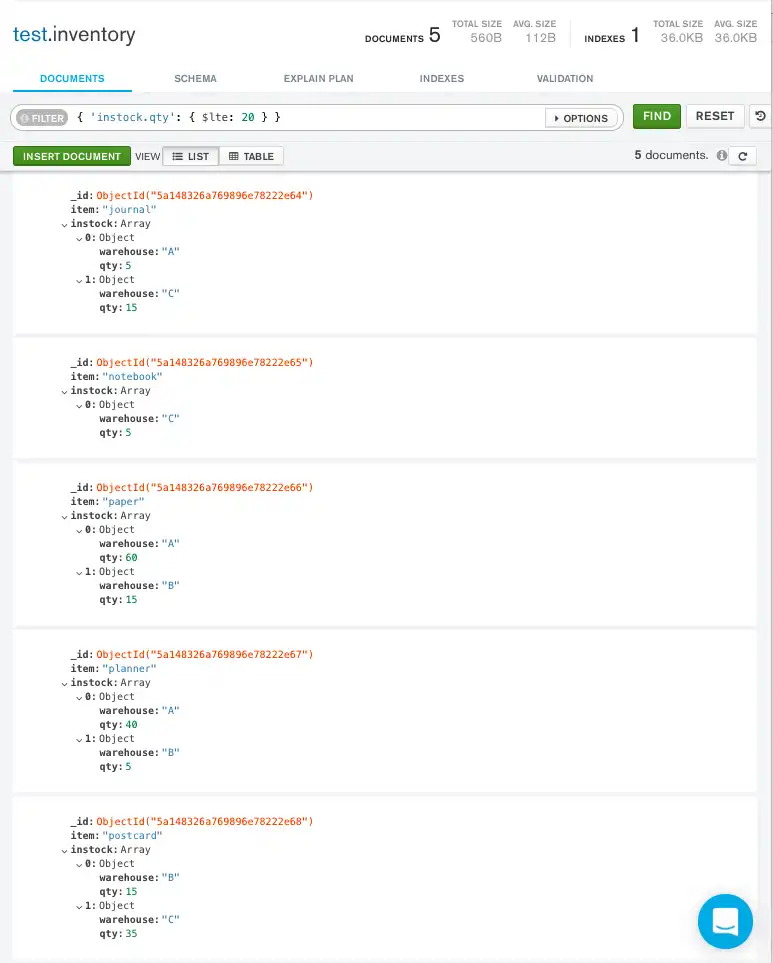
var filter = Builders<BsonDocument>.Filter.Lte("instock.qty", 20); var result = collection.Find(filter).ToList();
cursor, err := coll.Find( context.TODO(), bson.D{ {"instock.qty", bson.D{ {"$lte", 20}, }}, })
findPublisher = collection.find(lte("instock.qty", 20));
findIterable = collection.find(lte("instock.qty", 20));
cursor = db.inventory.find({"instock.qty": {"$lte": 20}})
const cursor = db.collection('inventory').find({ 'instock.qty': { $lte: 20 } });
$cursor = $db->coll("inventory")->find( { 'instock.qty' => { '$lte' => 20 } } );
$cursor = $db->inventory->find(['instock.qty' => ['$lte' => 20]]);
cursor = db.inventory.find({"instock.qty": {"$lte": 20}})
client[:inventory].find('instock.qty' => { '$lte' => 20 })
findObservable = collection.find(lte("instock.qty", 20))
Use the Array Index to Query for a Field in the Embedded Document
Using dot notation, you can specify query conditions for field in a document at a particular index or position of the array. The array uses zero-based indexing.
Note
When querying using dot notation, the field and index must be inside quotation marks.
The following example selects all documents where the instock array
has as its first element a document that contains the field qty
whose value is less than or equal to 20:
db.inventory.find( { 'instock.0.qty': { $lte: 20 } } )
Copy the following filter into the Compass query bar and click Find:
{ 'instock.0.qty': { $lte: 20 } }
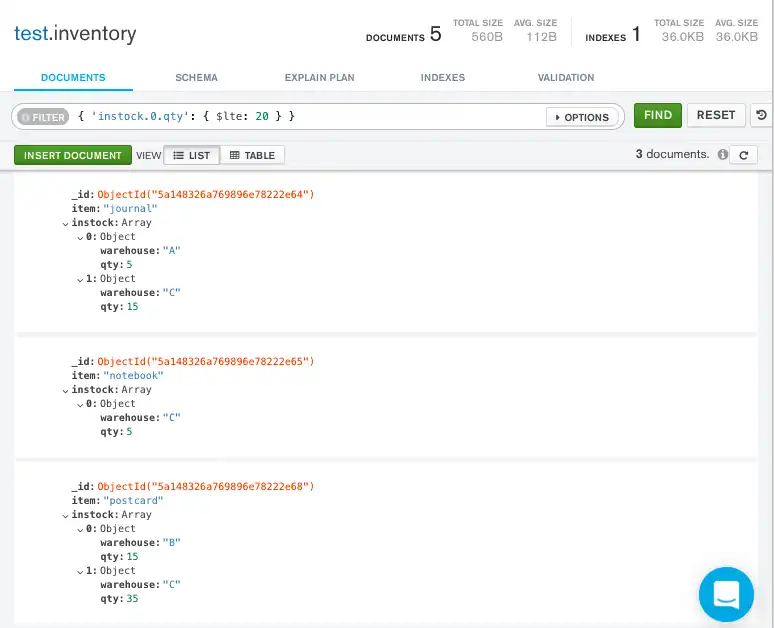
var filter = Builders<BsonDocument>.Filter.Lte("instock.0.qty", 20); var result = collection.Find(filter).ToList();
cursor, err := coll.Find( context.TODO(), bson.D{ {"instock.0.qty", bson.D{ {"$lte", 20}, }}, })
findPublisher = collection.find(lte("instock.0.qty", 20));
findIterable = collection.find(lte("instock.0.qty", 20));
cursor = db.inventory.find({"instock.0.qty": {"$lte": 20}})
const cursor = db.collection('inventory').find({ 'instock.0.qty': { $lte: 20 } });
$cursor = $db->coll("inventory")->find( { 'instock.0.qty' => { '$lte' => 20 } } );
$cursor = $db->inventory->find(['instock.0.qty' => ['$lte' => 20]]);
cursor = db.inventory.find({"instock.0.qty": {"$lte": 20}})
client[:inventory].find('instock.0.qty' => { '$lte' => 20 })
findObservable = collection.find(lte("instock.0.qty", 20))
Specify Multiple Conditions for Array of Documents
When specifying conditions on more than one field nested in an array of documents, you can specify the query such that either a single document meets these condition or any combination of documents (including a single document) in the array meets the conditions.
A Single Nested Document Meets Multiple Query Conditions on Nested Fields
Use $elemMatch operator to specify multiple criteria on an
array of embedded documents such that at least one embedded document
satisfies all the specified criteria.
The following example queries for documents where the instock array
has at least one embedded document that contains both the field
qty equal to 5 and the field warehouse equal
to A:
db.inventory.find( { "instock": { $elemMatch: { qty: 5, warehouse: "A" } } } )
Copy the following filter into the Compass query bar and click Find:
{ "instock": { $elemMatch: { qty: 5, warehouse: "A" } } }

var filter = Builders<BsonDocument>.Filter.ElemMatch<BsonValue>("instock", new BsonDocument { { "qty", 5 }, { "warehouse", "A" } }); var result = collection.Find(filter).ToList();
cursor, err := coll.Find( context.TODO(), bson.D{ {"instock", bson.D{ {"$elemMatch", bson.D{ {"qty", 5}, {"warehouse", "A"}, }}, }}, })
findPublisher = collection.find(elemMatch("instock", Document.parse("{ qty: 5, warehouse: 'A' }")));
findIterable = collection.find(elemMatch("instock", Document.parse("{ qty: 5, warehouse: 'A' }")));
cursor = db.inventory.find({"instock": {"$elemMatch": {"qty": 5, "warehouse": "A"}}})
const cursor = db.collection('inventory').find({ instock: { $elemMatch: { qty: 5, warehouse: 'A' } } });
$cursor = $db->coll("inventory")->find( { instock => { '$elemMatch' => { qty => 5, warehouse => "A" } } } );
$cursor = $db->inventory->find(['instock' => ['$elemMatch' => ['qty' => 5, 'warehouse' => 'A']]]);
cursor = db.inventory.find({"instock": {"$elemMatch": {"qty": 5, "warehouse": "A"}}})
client[:inventory].find(instock: { '$elemMatch' => { qty: 5, warehouse: 'A' } })
findObservable = collection.find(elemMatch("instock", Document("qty" -> 5, "warehouse" -> "A")))
The following example queries for documents where the instock array
has at least one embedded document that contains the field qty that
is greater than 10 and less than or equal to 20:
db.inventory.find( { "instock": { $elemMatch: { qty: { $gt: 10, $lte: 20 } } } } )
Copy the following filter into the Compass query bar and click Find:
{ "instock": { $elemMatch: { qty: { $gt: 10, $lte: 20 } } } }
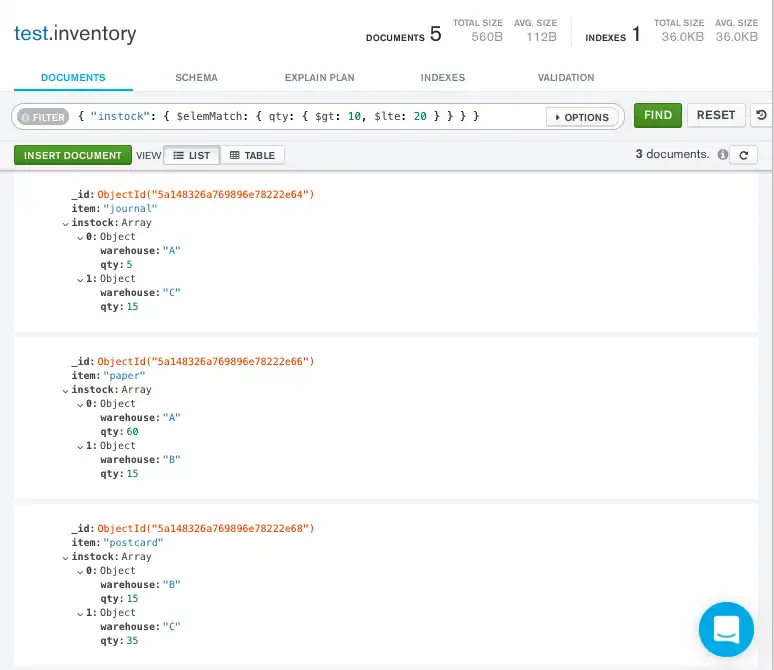
var filter = Builders<BsonDocument>.Filter.ElemMatch<BsonValue>("instock", new BsonDocument { { "qty", new BsonDocument { { "$gt", 10 }, { "$lte", 20 } } } }); var result = collection.Find(filter).ToList();
cursor, err := coll.Find( context.TODO(), bson.D{ {"instock", bson.D{ {"$elemMatch", bson.D{ {"qty", bson.D{ {"$gt", 10}, {"$lte", 20}, }}, }}, }}, })
findPublisher = collection.find(elemMatch("instock", Document.parse("{ qty: { $gt: 10, $lte: 20 } }")));
findIterable = collection.find(elemMatch("instock", Document.parse("{ qty: { $gt: 10, $lte: 20 } }")));
cursor = db.inventory.find({"instock": {"$elemMatch": {"qty": {"$gt": 10, "$lte": 20}}}})
const cursor = db.collection('inventory').find({ instock: { $elemMatch: { qty: { $gt: 10, $lte: 20 } } } });
$cursor = $db->coll("inventory") ->find( { instock => { '$elemMatch' => { qty => { '$gt' => 10, '$lte' => 20 } } } } );
$cursor = $db->inventory->find(['instock' => ['$elemMatch' => ['qty' => ['$gt' => 10, '$lte' => 20]]]]);
cursor = db.inventory.find({"instock": {"$elemMatch": {"qty": {"$gt": 10, "$lte": 20}}}})
client[:inventory].find(instock: { '$elemMatch' => { qty: { '$gt' => 10, '$lte' => 20 } } })
findObservable = collection.find(elemMatch("instock", Document("""{ qty: { $gt: 10, $lte: 20 } }""")))
Combination of Elements Satisfies the Criteria
If the compound query conditions on an array field do not use the
$elemMatch operator, the query selects those documents whose
array contains any combination of elements that satisfies the
conditions.
For example, the following query matches documents where any document
nested in the instock array has the qty field greater than
10 and any document (but not necessarily the same embedded
document) in the array has the qty field less than or equal to
20:
db.inventory.find( { "instock.qty": { $gt: 10, $lte: 20 } } )
Copy the following filter into the Compass query bar and click Find:
{ "instock.qty": { $gt: 10, $lte: 20 } }
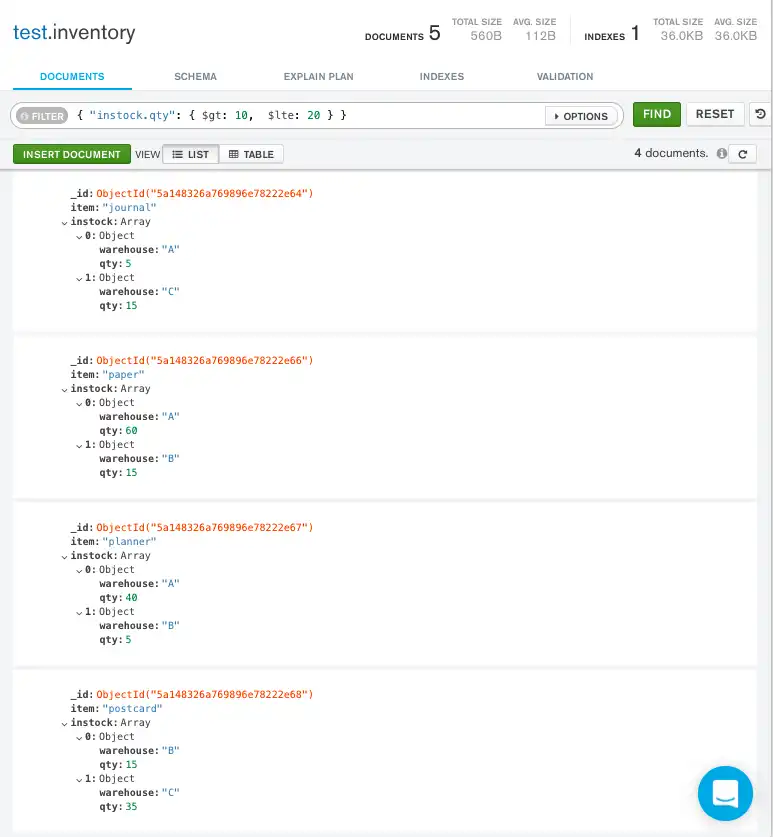
var builder = Builders<BsonDocument>.Filter; var filter = builder.And(builder.Gt("instock.qty", 10), builder.Lte("instock.qty", 20)); var result = collection.Find(filter).ToList();
cursor, err := coll.Find( context.TODO(), bson.D{ {"instock.qty", bson.D{ {"$gt", 10}, {"$lte", 20}, }}, })
findPublisher = collection.find(and(gt("instock.qty", 10), lte("instock.qty", 20)));
findIterable = collection.find(and(gt("instock.qty", 10), lte("instock.qty", 20)));
cursor = db.inventory.find({"instock.qty": {"$gt": 10, "$lte": 20}})
const cursor = db.collection('inventory').find({ 'instock.qty': { $gt: 10, $lte: 20 } });
$cursor = $db->coll("inventory")->find( { "instock.qty" => { '$gt' => 10, '$lte' => 20 } } );
$cursor = $db->inventory->find(['instock.qty' => ['$gt' => 10, '$lte' => 20]]);
cursor = db.inventory.find({"instock.qty": {"$gt": 10, "$lte": 20}})
client[:inventory].find('instock.qty' => { '$gt' => 10, '$lte' => 20 })
findObservable = collection.find(and(gt("instock.qty", 10), lte("instock.qty", 20)))
The following example queries for documents where the instock array
has at least one embedded document that contains the field qty
equal to 5 and at least one embedded document (but not necessarily
the same embedded document) that contains the field warehouse equal
to A:
db.inventory.find( { "instock.qty": 5, "instock.warehouse": "A" } )
Copy the following filter into the Compass query bar and click Find:
{ "instock.qty": 5, "instock.warehouse": "A" }
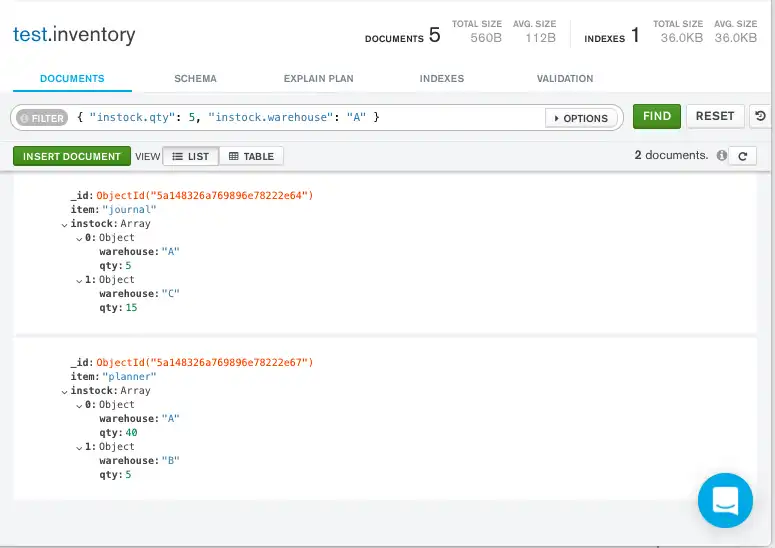
var builder = Builders<BsonDocument>.Filter; var filter = builder.And(builder.Eq("instock.qty", 5), builder.Eq("instock.warehouse", "A")); var result = collection.Find(filter).ToList();
cursor, err := coll.Find( context.TODO(), bson.D{ {"instock.qty", 5}, {"instock.warehouse", "A"}, })
findPublisher = collection.find(and(eq("instock.qty", 5), eq("instock.warehouse", "A")));
findIterable = collection.find(and(eq("instock.qty", 5), eq("instock.warehouse", "A")));
cursor = db.inventory.find({"instock.qty": 5, "instock.warehouse": "A"})
const cursor = db.collection('inventory').find({ 'instock.qty': 5, 'instock.warehouse': 'A' });
$cursor = $db->coll("inventory")->find( { "instock.qty" => 5, "instock.warehouse" => "A" } );
$cursor = $db->inventory->find(['instock.qty' => 5, 'instock.warehouse' => 'A']);
cursor = db.inventory.find({"instock.qty": 5, "instock.warehouse": "A"})
client[:inventory].find('instock.qty' => 5, 'instock.warehouse' => 'A')
findObservable = collection.find(and(equal("instock.qty", 5), equal("instock.warehouse", "A")))
Additional Query Tutorials
For additional query examples, see: